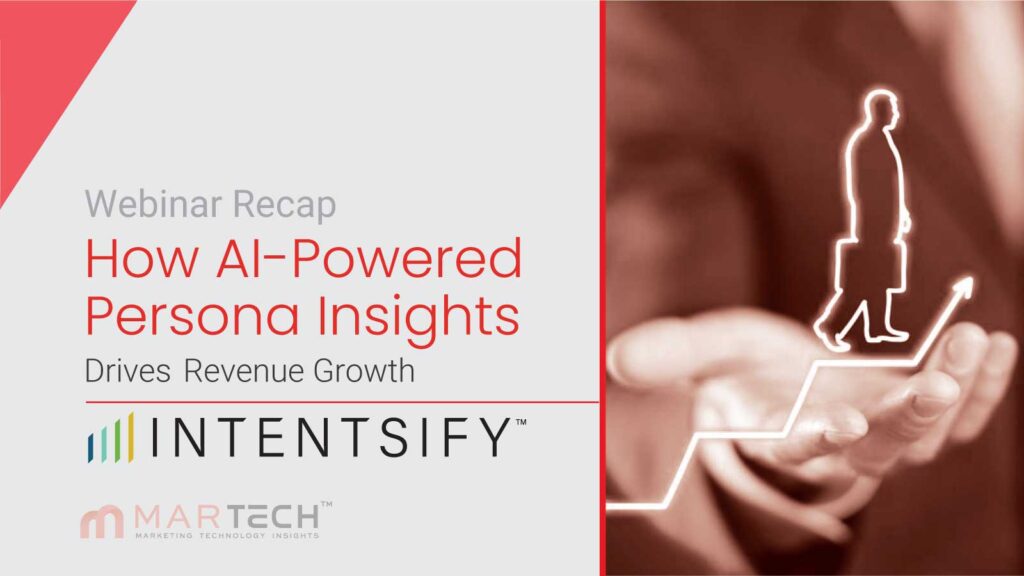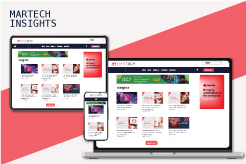“Persona insights” is the buzzword of the year. And, it is likely to garner more eyeballs in the coming months. The word “buyer persona” (coined by Alan Cooper¹) has been around for more than two decades now, but the phrase “persona insights” is taking the B2B marketing and sales economy by storm. Last month, Intentsify launched “Buying Group Intent Data”, an industry-disrupting enhancement to its buyer intelligence solution suite. Buying Group Intent Data highlights the strength of Intentsify’s proprietary AI-powered technology for high-growth revenue teams. It adds to the growing list of the company’s milestones in 2024, which witnessed the CEO Marc Laplante being recognized as an Entrepreneur Of The Year® 2024 New England Award Finalist, the launch of the B2B identity graph “Intentsify Orbit”, and winning the “Best Interaction Data Analytics Solution” award in the 7th annual MarTech Breakthrough Awards program.
Powered by AI buyer intelligence technology, Intentsify is a GTM enabler for high-growth marketing teams who seek accurate real-time B2B identity and intent data signals at the contact level. Overall, marketers can gain unparalleled insights into their target audience, creating personalized campaigns to target specific decision-makers within accounts for faster deal closures.
Today, our MarTech media team attended Intentsify’s game-changing webinar, titled “Unlocking the Buying Group: AI-Powered Persona Insights for Revenue Growth.”
The speakers included:
- David Crane, VP of Product Marketing at Intentsify
- Apparao B Karri, Chief Product Officer at Intentsify
- Kelvin Gee, Principal Analyst for Demand and Account-based Marketing at Forrester
Key Takeaways From Today’s Webinar, Listed by MarTech Insights Media Room
Takeaway #1: Shift focus from leads and accounts to “Buyer Groups”
Traditional B2B Marketing Focuses on 2 Approaches:
- Lead-based approach
- Account-based approach
Both approaches have their own sets of challenges and difficulties. For instance, lead-based approaches ignore buying intent signals while account-based ones neglect the actual requirements of different decision-makers within the same in-market account groups.
How do Marketers Overcome these Problems?
With a Buyer Group-led approach to GTM.
Why Buyer Groups?
Buyer groups have the authority to make purchasing decisions.
By definition, a buying group is a defined set of roles and titles within an organization that specializes in purchasing a product, solution, or service from a supplier. A buying group could be an individual or a group of people, depending on the size and span of managerial activities that show interest in purchasing from a vendor.
During the webinar, Kelvin Gee explained why vendors should shift to buyer group-focused marketing and sales campaigns to drive revenue growth. He gave a fine example highlighting the role of Marketing Technologies such as Marketing Automation Platforms (MAP) and Account-based Marketing (ABM) solutions that help marketing teams identify and analyze MQLs at a lead and accounts level. However, conversions likely happen at the buyer group level (also called people’s level), and that’s where Intentsify’s Buyer Group Intent Data solution can be useful at every stage of the buyer’s journey.
Recommended MarTech Insights and News: Intentsify Launches Largest B2B Identity Graph for Marketing
Takeaway #2 Unlocking buyer group insights with AI
During the webinar, speakers revealed that 92% of B2B1 buying decision groups have 2 or more buying group members with different roles and job titles.
Common Roles are Categorized as:
- Champions
- Decision-makers
- Influencers
- Users
- Ratifiers
For a 100% lead-to-account matching, identifying these roles requires high-end technology. Merely relying on MAPs or ABM stack of Omnichannel orchestration or CDP-powered engagement solutions can’t provide a complete picture. That’s where AI-powered Intent Orbit comes into the picture.
Artificial Intelligence can predict and simulate how buying groups interact with content and other digital assets before making purchasing decisions. According to Forrester’s recent report titled, “The Seven Must-Dos: How Buying Groups Change Everything”, AI-powered technology greatly simplifies how marketers identify, analyze, and visualize the buying behaviors of the purchasing groups — anonymous or known. Buying Group Intent Data solution sits at the center of the Intent Orbit, indicating intent-based topic scores for each target persona within an account, indicating how one or more topic areas or content was researched at the early or late stages of the buying journey.
Top MarTech News and Insights: Twilio Integrates OpenAI’s Realtime API for Conversational AI
Likewise, the same solution enables filters to identify specific job titles and functions of the persona that showed the highest propensity to research a topic before a purchasing decision.
Takeaway #3 Debunking MQL myths, and decoding the buyer obsession
MQL-Focused B2B Processes Common Issues
Let’s speak the truth first. All MQL-focused B2B processes have these common issues:
- They run on inefficient processes
- They generate wasted budgets
- They drag the systems and extend the sales timeline
During the webinar, Kelvin highlighted the reality of working with leads and accounts in a traditional B2B marketing scenario. One of the biggest myths of working with MQLs is to “wrongly” identify an MQL as a buyer. At best, an MQL is an indication of interest and not an indication of buying intent. The growing GTM obsession with embracing buying group intent data pivots on the need to gather better insights and analytics on MQL engagement, account-based targeting, and buying group intent signals. Once identified, it is easier to establish whether an MQL engagement can convert or translate to “buying propensity” now or in the future.
The webinar explained how buyer persona differs from accounts and market supersets, indicating why B2B marketers should focus on engaging with buyers identified at the CONTACT-level, instead of engaging at an account level or MQL level.
Takeaway #4 Understanding the types of Intent Signals
To succeed with GTM-focused campaigns, marketers must embrace signal-based marketing at an account level or buying persona level.
Moreover, Apparao explained the importance of buyer intelligence signal activation in driving high-quality engagements that result in sales and perpetual revenue generation opportunities.
Buying Group Intelligence allows marketers to work with intent signals generated from first-party intent sources, funneling the intent signals from second-party and third-party intent sources with AI-matching capabilities. These activities, powered by AI, strengthen the intent data signals through elaborate topic-interest scores generated by identifiable buying groups.
Conclusion
The buyer’s journey is fluid — and often construed as being far too complex than previously understood. Having access to a strong intent data signal platform such as Intentsify that focuses on buying groups can help marketers and revenue ops teams get closer to understanding the target audience’s unique needs and preferences, and tailoring signal-based marketing efforts accordingly. By recognizing the dynamic nature of the buyer’s journey, you can develop more effective marketing strategies that resonate with your audience and drive conversions. AI-powered persona insights for revenue growth are within the reach of modern B2B marketing teams. Intentsify’s webinar proves it.
And, That’s a Wrap
For media inquiries, you can write to our MarTech Newsroom at news@intentamplify.com
Editor’s note: The Marketing team at Intent Amplify™ attended the webinar to curate this content. This is a non-sponsored non-commercial article, written to generate awareness among the Martech audience.
- Inmates Are Running the Asylum, The: Why High-Tech Products Drive Us Crazy and How to Restore the Sanity, by Alan Cooper



